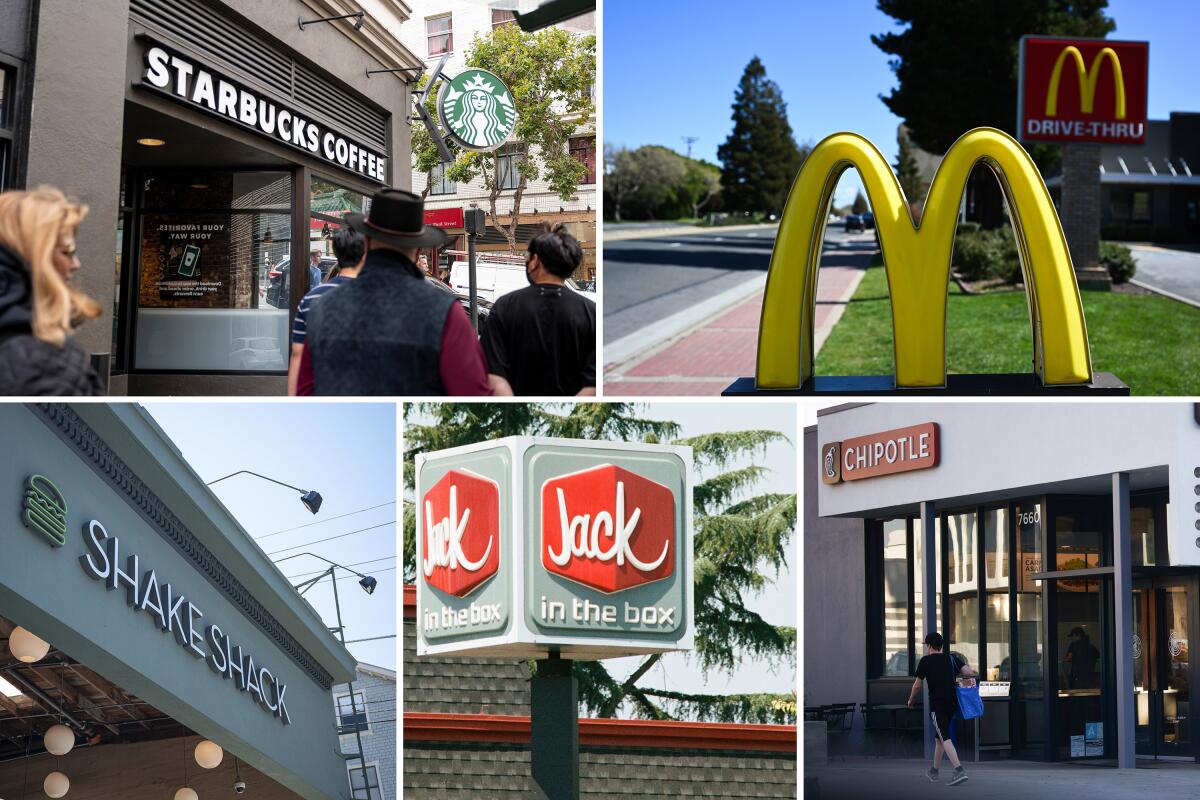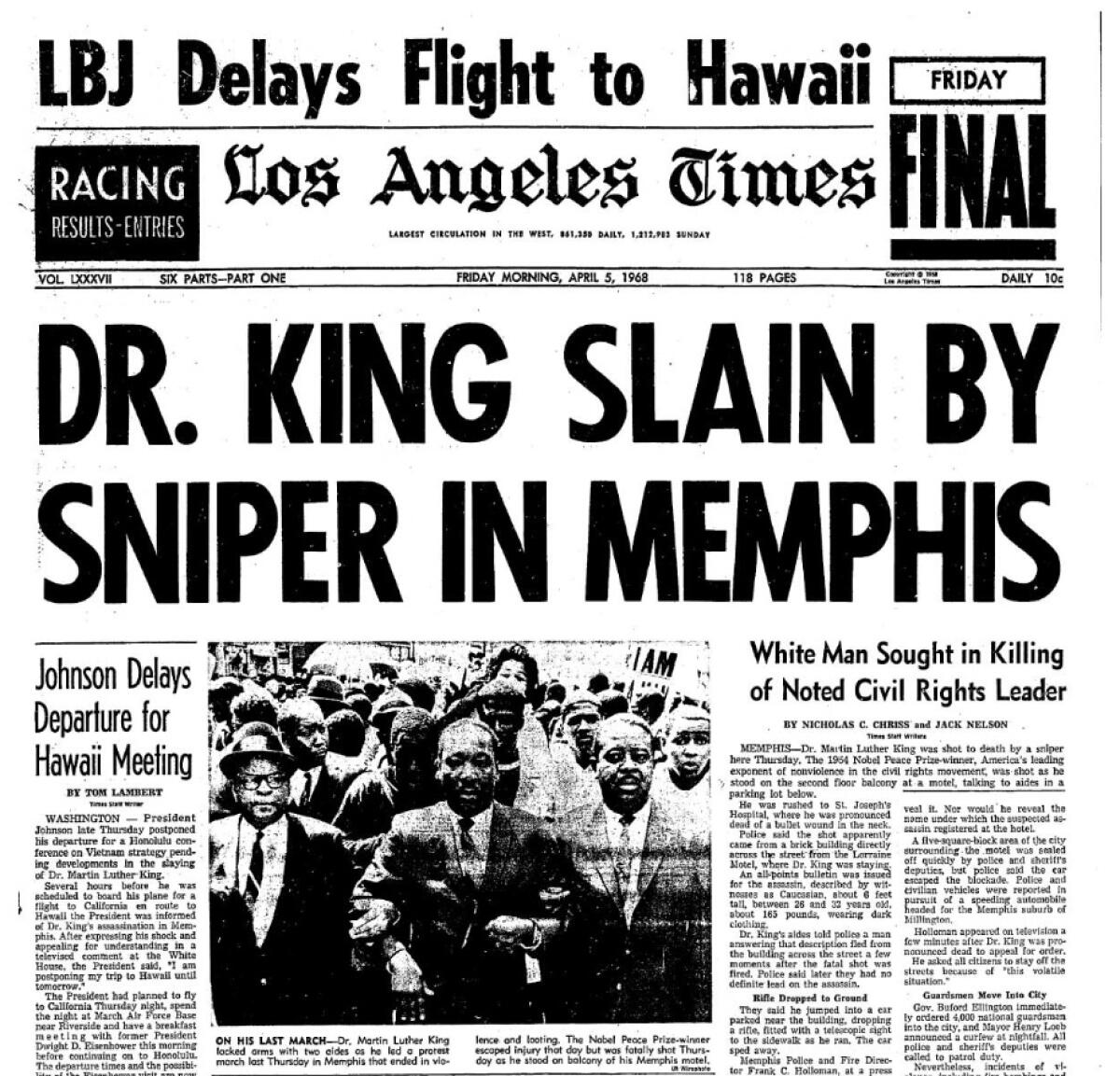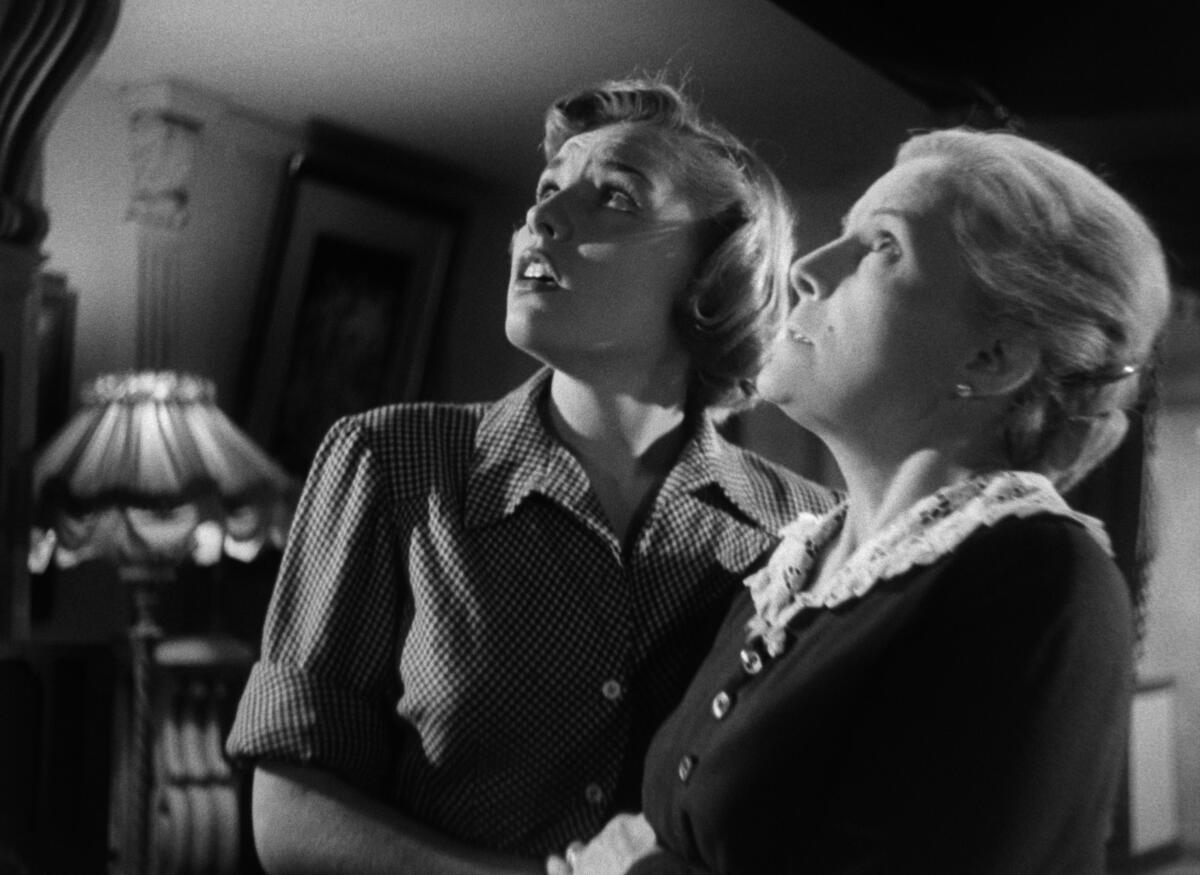Excitement, relief, dread. What $20 an hour means, according to fast-food workers, franchise owners, customers

- Share via
Good morning. It’s Thursday, April 4. This is Ryan Fonseca and I’m joined by our reporting fellow Defne Karabatur. Here’s what you need to know to start your day.
- What California’s $20 fast-food wage means for workers, franchise owners and customers
- Scientology tried to ‘derail’ Danny Masterson’s rape trial by harassing prosecutor, suit says; church calls claim ‘false.’
- The movies worth seeing at UCLA’s Festival of Preservation.
- And here’s today’s e-newspaper
Sign up for Essential California
The most important California stories and recommendations in your inbox every morning.
You may occasionally receive promotional content from the Los Angeles Times.
What $20 an hour means, according to fast-food workers, franchise owners, customers
A sweeping change unfolded this week inside fast food chains like McDonald’s, El Pollo Loco and Starbucks. The food is the same. But the hourly minimum wage of the workers who serve you is now $20, a notable increase from the previous $16. And the price of that burger or cup of coffee may be rising.
Gov. Gavin Newsom signed Assembly Bill 1228 last year, affecting fast-food chains with more than 60 locations nationwide and more than 500,000 fast-food workers in California. The Times has been regularly covering the wage increase and its potential impacts, including the possibility of price hikes as fast-food operators pass on the increased labor costs to consumers.
We wanted to hear from all sides affected by the new law — primarily workers, but also the franchise owners and customers. We emailed, we called — and we just walked into some restaurants to talk to people. Here’s what they told us:
Workers are excited (plus a little worried)
We asked the workers one basic question: What does the $20 minimum wage mean for you?
Scarlett Arana has worked at an El Pollo Loco in the San Gabriel Valley for about eight months. The 19-year-old said the larger paychecks will be a major help as she struggles with high housing costs and inflation. She said she is literally bringing the money home, where she lives with her family, to pitch in more toward bills.
“I get to not only help out more with rent, but I get to help with other utilities as well [and] groceries,” Arana said. “It’s gonna do really good for us.”
Arana is also somewhat concerned that the higher hourly wage could lead to decreased hours — and that inflation could keep creeping up to where her pay bump flattens out.
“That’s the main thing I worry about,” she said.
Dennise Rodriguez, 20, is the primary wage earner in her family — and the pressure has been intense.
She’s been working at a Wendy’s in the San Gabriel Valley for about a year while juggling classes at Mt. San Antonio College. She’s studying early childhood education and plans to become an elementary school teacher.
“You have to put in so many hours just to reach a certain goal for your rent,” she said from a booth at work, still wearing her drive-through headset. “I have to provide for my school — and school’s expensive.”
Rodriguez lives at home with her parents and younger siblings. Her mother recently gave birth via C-section and can’t return to work yet and her father is on disability after a workplace injury.
“I’m the one who’s bringing in the income,” she said. “So it’s a little hard.”
For Rodriguez, the higher hourly wage will mean less pressure to work 40-plus hours each week, giving her more time to focus on school “or even get a mental break from work and school,” she said.
Still, Rodriguez is worried that her larger paychecks might not stretch as far in the long run “because California itself is expensive.”
“Yeah, the minimum wage is going higher, but then what’s next?” she wondered. “I just feel like, at the end of the day, it’s gonna come back down to everything rising. It’s not really going to be a living [wage].”
Family-run franchises feel targeted
The California Alliance of Family Owned Businesses gave us a statement reflecting how many of their members are feeling. The group said state lawmakers “have singled out family-owned fast food franchise operators to target with wage and regulatory requirements not imposed upon other businesses.”
“As family-owned businesses, we are proud to provide jobs and opportunities for our valued employees but we also want an even playing field,” the statement reads. “The minimum wage for one should be the same for all.”
Mike Mangione, 74, exemplifies what it means to operate a family owned business. He worked at McDonald’s in Chicago in the late 1960s. As a loyal employee, in 1967, Mangione bought a Long Beach McDonald’s with his father.
Now, 57 years later, Mangione owns and operates 19 McDonald’s restaurants across L.A. and the Inland Empire with his daughter, Jessica D’Ambre, and son, Anthony.
For Mangione and his children, being a franchisee is about more than owning McDonald’s locations. Both of his kids have worked in the kitchen and helped with maintenance. They have taken orders and processed payments, before becoming managers and ultimately licensed operators.
“We run it like any other family business,” D’Ambre, 37, said, adding that she knew she wanted to be her dad’s business partner from the age of 5. “I celebrate birthdays with my employees, we celebrate Christmases together.”
D’Ambre feels the new law is like an “unfair target on our backs.”
“It’s not just this giant corporation that runs things,” D’Ambre, who has more than 20 years of experience in the industry, said. “I think that’s where the misconception lies, especially with politicians. They don’t understand the business and the tight margins we run on.”
D’Ambre said she and her family are trying to approach the change from a positive perspective.
“Maybe there are great people out there who never considered working at McDonald’s before and who never considered this as an option but now they will,” D’Ambre said. Instead of laying off workers, she thinks she will “be hiring more people that are friendlier and faster than before.”
D’Ambre said that she doesn’t foresee any layoffs at her locations and those who “work hard and give our customers a great experience are going to be fine.”
It’s too soon to know whether she will raise prices and she will evaluate each location uniquely. Some of her employees “feel excited,” while “there are other people who are more realistic.”
“Are we really helping anybody?” she asked. “I don’t really know.”
Fewer takeout bags, more leftovers
Wearing a blue Dodgers cap and matching jacket, Jose Navarro was enjoying his lunch at the El Pollo Loco in Marina del Rey on Monday.
The 50-year-old South Gate resident had packed leftovers, fearing that the new law might immediately increase the price of his go-to meal: chicken thighs, mashed potatoes with gravy, mac-and-cheese and flour tortillas. But he forgot his lunch at home.
Navarro said he frequents fast-food restaurants during the workweek because it’s easier to eat a warm lunch. He often works outside the office as a customer service administrator at a telecommunications company — and reheating leftovers isn’t always an option. He may have to change habits if prices go up.
“Before, it was like, ah I don’t want to carry it,” Navarro said. But now, he said he is going to ask himself “Is it really worth paying?” Will he have to “cut back maybe a day or two,” instead of relying on eating out most days?
However, when he needs to, he’ll pay whatever the new price is.
“Everybody should make a living wage,” Navarro said. But he also worries owners could react by cutting workers’ hours or laying them off — maybe replacing them with machines.
“What seemed to be a good idea is actually going to hurt the people that [the law is] trying to help,” he said. “But maybe this will be a good example for other states that might be thinking about doing the same.”
Today’s top stories
Scientology
- Scientology tried to ‘derail’ Danny Masterson’s rape trial by harassing prosecutor, suit says; church calls claim ‘false.’
- Masterson was convicted of two counts of rape in May of last year.
Stolen artifacts in California museums
- Investigators think LACMA, Norton Simon and other California museums have Cambodia’s looted antiquities. Go inside Cambodia’s quest to get them back.
- In a highly unusual move, UCLA Fowler Museum initiated returns of looted African works in February.
California and criminal justice reform
- After a trip to Alabama that helped him see the connection between slavery and the death penalty, Santa Clara County Dist. Atty. Jeff Rosen is working to call back the death sentences of 18 men convicted from his county.
- Newsom has approved three California prison closures but resists pressure to shutter more.
- Newsom closed death row. He’s not exactly hyping that right now, Anita Chabria writes.
Massive Taiwan earthquake leaves destruction
- Taiwan’s strongest earthquake in 25 years killed nine people and trapped 70 workers in quarries.
- What California can learn from the massive earthquake off the coast of Taiwan.
Bob Iger triumphed over Nelson Peltz in Disney’s bitter shareholder vote
- The hard-fought battle focused a harsh light on Disney’s challenges, including finding a successor for CEO Bob Iger.
- Meet the man who battled Bob Iger.
Why the 2024 election is unique
- “Double-Haters,” who want neither Trump nor Biden, make up as much as a fifth of the electorate. The path to the White House means winning them over.
- Meet Don Hankey, the L.A. billionaire who financed Donald Trump’s appeal bond.
- It’s an election between authoritarianism and the uncommitted, wrote our columnist Anita Chabria.
- Every vote counts in Silicon Valley, where two congressional candidates literally tied for second place.
Allegations against Andy Cohen’s Bravo empire
- Andy Cohen turned Bravo into a cable powerhouse. Now the network and its producers face a slew of allegations and lawsuits claiming bullying, harassment and unfair labor practices.
- “Real Housewives” star Leah McSweeney sued the TV personality, Bravo and NBCUniversal in February for encouraging a “dangerous work environment” and “substance abuse”. Cohen’s rep called it “completely false.”
It’s suddenly cold again (and still wet)
- Expect winter temps and low-elevation snow across California starting today.
- ‘Way, way, way above normal’ rains could set an all-time L.A. record.
- Officials urging residents near the latest Big Sur landslide to evacuate as more rain approaches.
More big stories
- In one of L.A.’s largest cash heists, burglars stole $30 million on Easter. Mystery surrounds the case.
- A new video finally reveals the truth of how police killed abducted teen Savannah Graziano.
- Peter Schey, longtime Los Angeles champion of immigrant rights, dead at 77.
- Paris Hilton backs California bill to reform ‘troubled teen industry.’
- Sage Against the Machine, an L.A.-based band of punk-rock native plant nerds, might do for native plants what the Beach Boys did for surfing.
- Poppies across Southern California aren’t popping, even as other bright flowers blanket the region. Here’s why.
- Jon Stewart continues his ‘Daily Show’ comeback with a major dig at his former employer.
- LeBron James on Bronny James’ future: ‘He has some tough decisions to make.’
Get unlimited access to the Los Angeles Times. Subscribe here.
Commentary and opinions
- Lorraine Ali: I spent 24 hours on Trump’s Truth Social so you don’t have to. No wonder it’s tanking.
- Mary McNamara: Bob Iger, you beat Nelson Peltz. So don’t give into his retrograde agenda.
- Michael Hiltzik: Disney needs fixing, but Peltz was the wrong repairman.
- Harry Litman: How Jack Smith just called out Judge Aileen Cannon in the Trump classified records case
- Editorial Board: Berkeley’s backtrack on gas ban won’t stop the electrification trend
Today’s great reads
L.A. synagogue’s invite to Muslims on Ramadan ends in tears and resignations. Can they heal? A Jewish temple in the San Fernando Valley opened its doors to Muslims for Ramadan. When word spread among the congregation that a display of photos of Israeli hostages had been covered, there was an uproar.
Other great reads
- A trash-covered home in L.A. draws outrage, worry and a ‘Hoarders’ producer.
- This teacher will guide you into talking with your dreams. A warning: They will talk back.
How can we make this newsletter more useful? Send comments to [email protected].
For your downtime
Going out
- 📽️ These are the movies worth seeing at UCLA’s Festival of Preservation, which starts Friday.
- 🌱 18 ways to volunteer with native plants in and around L.A.
- 🎤 The son of Sublime’s Bradley Nowell gives the band a ‘second beginning’ in time for Coachella.
- ☀️ How to take a photo of the eclipse without damaging your phone.
Staying in
- 🍽️ Here are 2024’s James Beard Award nominees in Los Angeles — and all of California
- 📖 The 3 best mystery books to read this spring.
- 📺 ‘Elsbeth’: the non-spin-off spin-off from ‘The Good Wife’ universe.
- 🧑🍳 Here’s a recipe for Pho Gà Nhanh (Quick Chicken Pho).
- ✏️ Get our free daily crossword puzzle, sudoku, word search and arcade games.
And finally ... from our archives

On April 4, 1968, the Rev. Dr. Martin Luther King Jr. was shot in Memphis. Fifty years later, the Times looked back on his death, and more events from 1968, one of our nation’s most tumultuous years.
Have a great day, from the Essential California team
Ryan Fonseca, reporter
Defne Karabatur, fellow
Stephanie Chavez, deputy metro editor
Christian Orozco, assistant editor
Karim Doumar, head of newsletters
Check our top stories, topics and the latest articles on latimes.com.
Sign up for Essential California
The most important California stories and recommendations in your inbox every morning.
You may occasionally receive promotional content from the Los Angeles Times.








